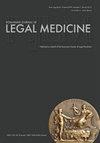Matricide During Covid-19 Pandemic: An Unusual Case of Family Violence
IF 0.4
4区 医学
Q4 Medicine
引用次数: 3
Abstract
The need to limit the spread of the virus in the population has forced many countries to impose strict measures of social distancing and home isolation. These measures, although necessary, have caused unprecedented social disruption. One of the most worrying effects of this social crisis is the increase in episodes of family violence which can be extremely serious up to the killing of family members. Matricide is a fairly rare event worldwide. Many authors have over time attempted to figure out the origins of a pathological condition-but not limited to-underlying such crimes often executed through particularly brutal criminal acts against the victims. In this study we present a case of a 66-year-old woman who was killed with multiple stab wounds from a diving knife and then burned. It was determined that the victim was murdered by her 36-year-old son, unemployed for about a year and with a history of alcohol abuse, had a suspected diagnosis of bipolar disorder in treatment with antidepressant drugs. On the victim’s body there were 31 stab wounds, localized mostly to the skull, face and thorax. Some of the typical characteristics highlighted in the literature regarding individuals who commit matricide are actually found in this case. This correspondence underscores the need to recognize and, in some cases, prevent the possible occurrence of such an eventuality within a family.新冠肺炎大流行期间的杀母:一个罕见的家庭暴力案例
限制病毒在人群中传播的必要性迫使许多国家采取严格的社交距离和居家隔离措施。这些措施虽然必要,却造成了前所未有的社会混乱。这场社会危机最令人担忧的影响之一是家庭暴力事件的增加,这种暴力事件可能极其严重,甚至导致家庭成员死亡。在全世界范围内,杀害女性是相当罕见的事件。随着时间的推移,许多作者试图找出一种病理状态的起源,但不限于这种犯罪的根源,这种犯罪通常是通过对受害者的特别残忍的犯罪行为来实施的。在这项研究中,我们介绍了一名66岁的妇女的案例,她被潜水刀刺伤多处,随后被烧伤。经确定,受害者是被她36岁的儿子谋杀的,儿子失业约一年,有酗酒史,在接受抗抑郁药物治疗时被诊断为双相情感障碍。受害者身上有31处刺伤,大部分位于头骨、面部和胸部。文献中强调的关于被录取者的一些典型特征实际上就是在这种情况下发现的。这封信强调,需要认识到并在某些情况下防止这种情况在家庭中可能发生。
本文章由计算机程序翻译,如有差异,请以英文原文为准。
求助全文
约1分钟内获得全文
求助全文
来源期刊
CiteScore
0.50
自引率
25.00%
发文量
0
审稿时长
6-12 weeks
期刊介绍:
The Romanian Journal of Legal Medicine, the official publication of the Romanian Legal Medicine Society, is devoted to the publication of the original investigations, observations, scholarly inquiries and reviews in the various branches of the forensic sciences.
These include forensic pathology and histochemistry, clinical forensic medicine, medical malpractice, traffic medicine, chemistry, biochemistry, thanatochemistry, clinical and forensic toxicology, alcohology, biology (including the identification of hairs and fibres), the physical sciences, firearms, and document examination, physical anthropology, serology, forensic genetics and paternity (with special emphasis on recent advances in DNA technology and PCR), forensic psychiatry and behavioral sciences, forensic odontology, law and ethics, history of forensic sciences. RJLM also includes similar submissions dealing with forensic-oriented aspects of the social science and the area where science and medicine interact with the law.

 求助内容:
求助内容: 应助结果提醒方式:
应助结果提醒方式:


